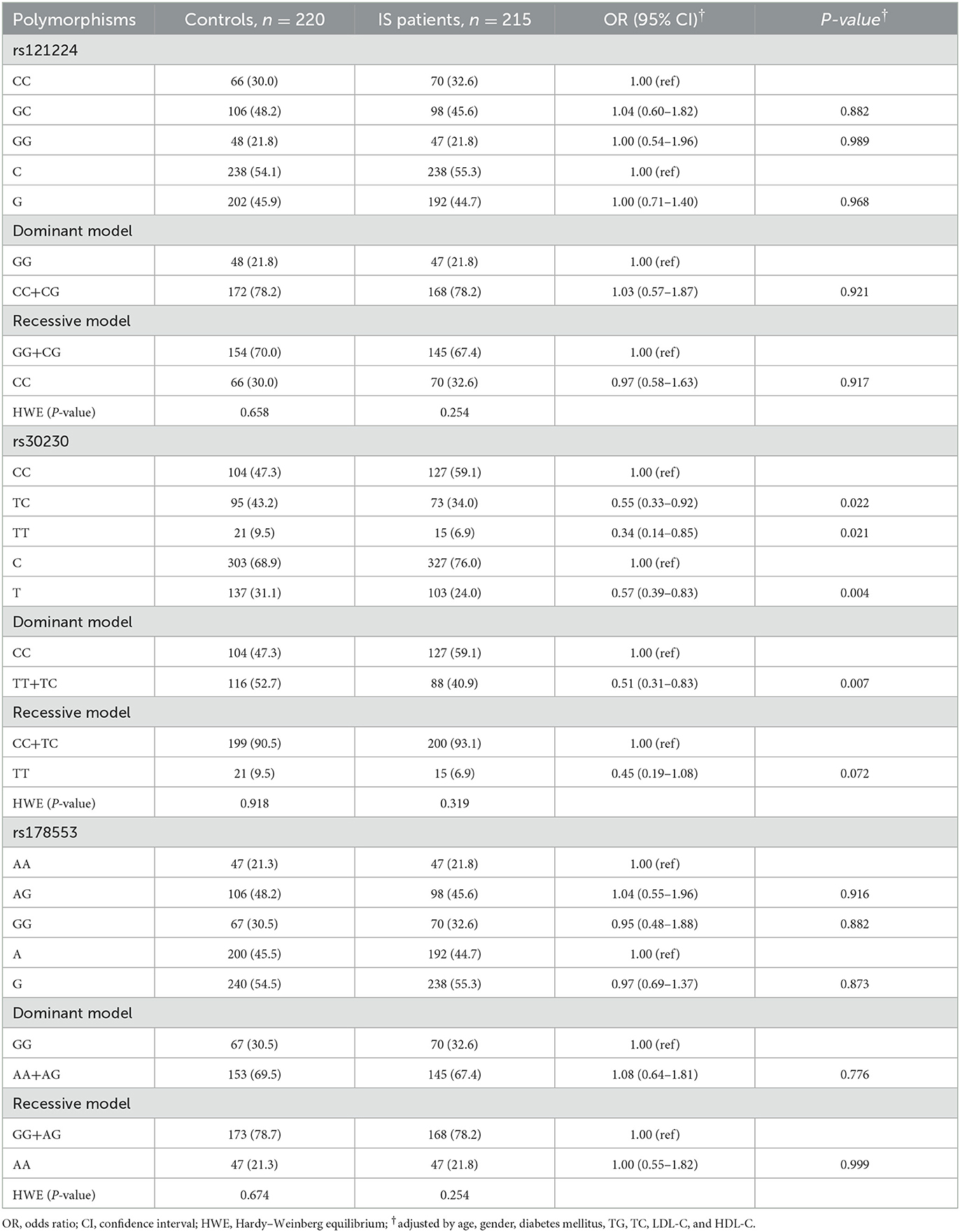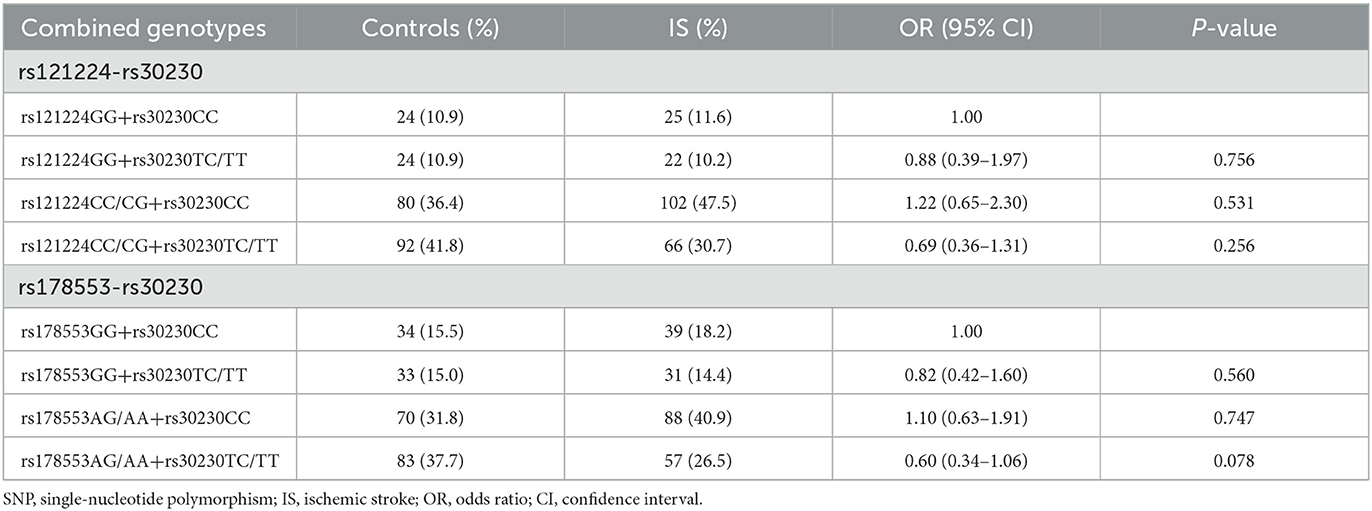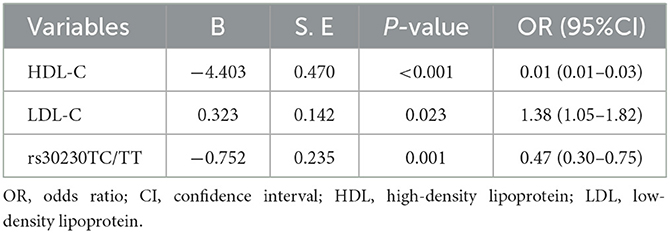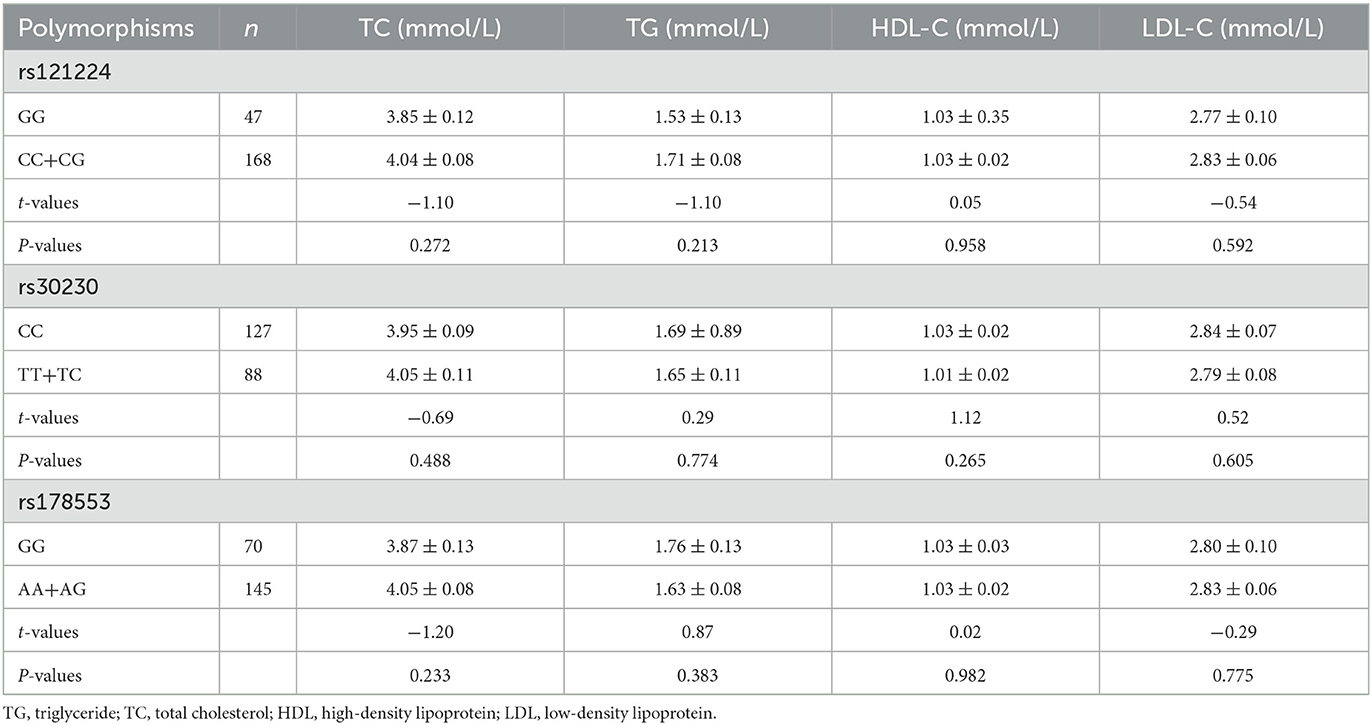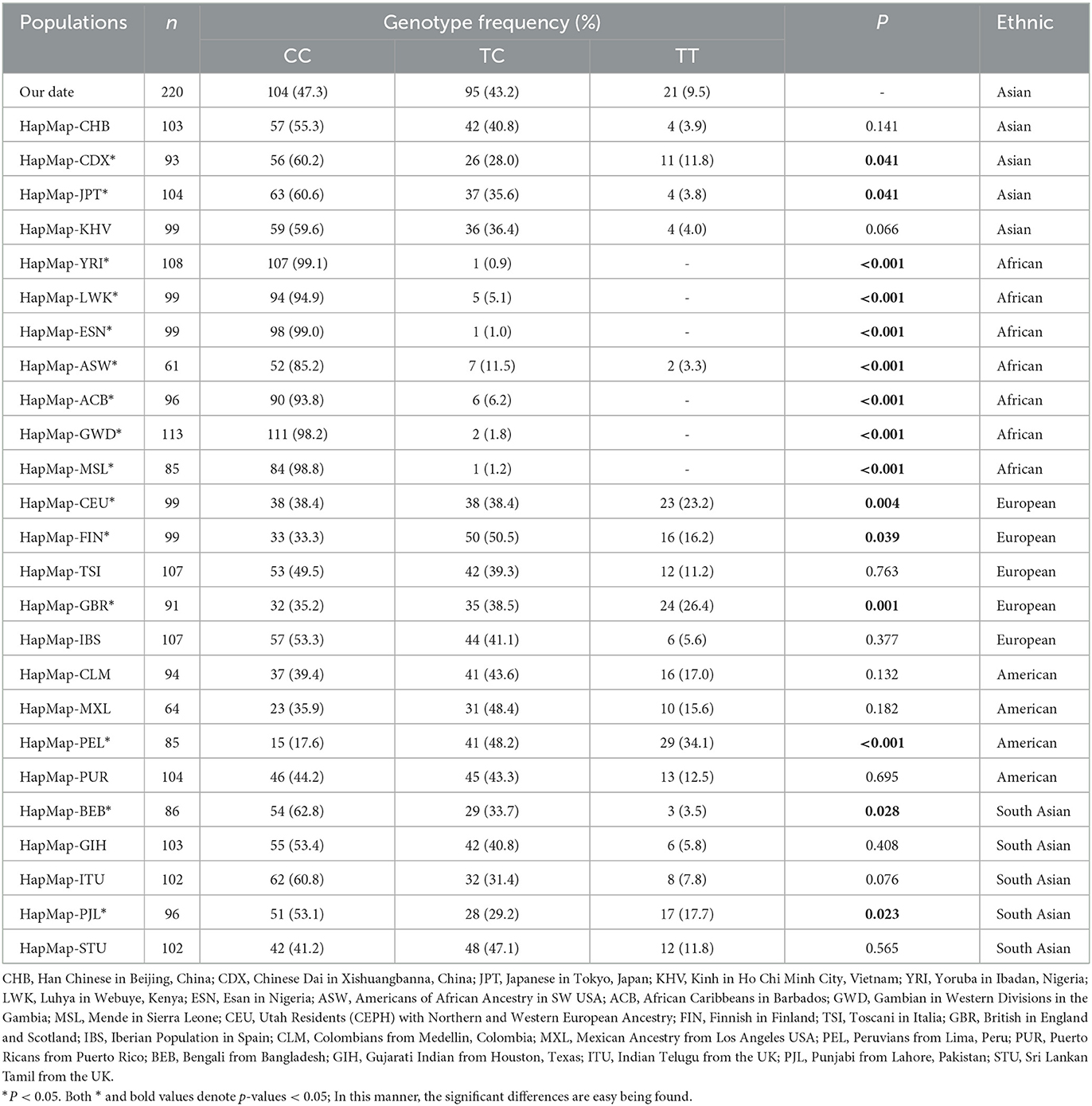- 1Department of Laboratory Medicine, The Second Affiliated Hospital of Guilin Medical University, Guilin, China
- 2College of Medical Laboratory Science, Guilin Medical University, Guilin, China
- 3School of Clinical Medicine, Guilin Medical University, Guilin, China
- 4Guangxi Health Commission Key Laboratory of Glucose and Lipid Metabolism Disorders, Guangxi Key Laboratory of Metabolic Reprogramming and Intelligent Medical Engineering for Chronic Diseases, The Second Affiliated Hospital of Guilin Medical University, Guilin, China
Background: Ischemic stroke (IS) represents a major cause of morbidity and mortality across the globe. The aberrant expression of miR-365 has been found to be implicated in a wide array of human diseases, including atherosclerosis and cancer. Studies on single-nucleotide polymorphisms (SNPs) in miRNA genes can help gain insight into the susceptibility to the condition. This study aimed to examine the relationship between miR-365 SNPs and the risk of IS.
Methods: The study recruited 215 IS patients and 220 controls. The SNPscans genotyping was employed to genotype three polymorphic loci (rs121224, rs30230, and rs178553) of miR-365. The relative expression of miR-365 in peripheral blood mononuclear cells of the patients and controls was determined by using real-time quantitative PCR.
Results: The miR-365 rs30230 polymorphism exhibited a significant association with the risk of developing IS (TC vs. CC: adjusted OR = 0.55, 95% CI: 0.33-0.92, P = 0.022; TT vs. CC: adjusted OR = 0.34, 95% CI: 0.14–0.85, P = 0.021; TC +TT vs. CC: adjusted OR = 0.51, 95% CI: 0.31–0.83, P = 0.007; T vs. C: adjusted OR = 0.57, 95% CI: 0.39–0.83, P = 0.004). Haplotype analysis revealed that the C-T-G haplotype was associated with a decreased risk of IS (OR = 0.68, 95% CI: 0.46–1.00, P = 0.047). Furthermore, miR-365 expression was significantly higher in IS patients than in controls (P < 0.001). Interestingly, patients with rs30230 TC or TT genotypes had lower miR-365 levels compared to their counterparts with CC genotypes (P < 0.001).
Conclusions: The miR-365 rs30230 polymorphism might bear an association with IS susceptibility in the Chinese population, and the rs30230 TC/TT genotype might be a protective factor against IS.
1. Introduction
Stroke represents a highly prevalent cardiovascular and cerebrovascular disease globally and is characterized by a significantly higher morbidity and mortality. With annual deaths standing at 50,000, it ranks as the second most lethal disease worldwide (1, 2). The rising incidence and the sheer patient numbers impose an immense burden on medical resources and society at large (3). Ischemic stroke (IS) is etiologically multifactorial and is linked to various risk factors, including age, gender, smoking, alcohol abuse, diabetes, hyperlipidemia, and hyperhomocysteinemia (4, 5). In addition to those well-established factors, genetic factors have increasingly been on the radar of researchers due to their association with ischemic stroke. Extensive evidence now supports the involvement of genetic variants in the susceptibility to IS (6–9). MicroRNAs, a class of endogenous small non-coding RNAs, are highly conservative across species and typically consist of 18–22 nucleotides. They primarily regulate gene expression in vivo by binding complementarily to the 3′UTR of target mRNAs, thereby modulating mRNA translation via repressing or degrading their target RNAs at the transcriptional level (10, 11). Currently, mounting evidence suggests that a wide array of microRNAs is implicated in the progression of IS. For instance, miR-497 was reported to be closely associated with unfavorable prognosis of IS patients (12), and the overexpression of miR-181c was shown to exacerbate cerebral damage in patients with acute ischemic stroke (13). As a member of the microRNA family, miR-365 was reportedly linked to some mechanistic processes, such as IL-6 regulation and vascular smooth muscle cell proliferation, both being involved in the pathogenesis of atherosclerosis (14, 15). Atherosclerosis is intimately correlated with cardiovascular and cerebrovascular diseases, including coronary heart disease and IS. Moreover, miR-365 expression was found to be aberrant in a rat model of middle cerebral artery occlusion, and it was shown to take part in the development, progression, and prognosis of stroke via multiple mechanisms (16, 17). On the basis of these findings, we are led to speculate that miR-365 might serve as a biomarker for the early diagnosis and prognostic assessment of IS and a target for the early intervention of IS.
Single-nucleotide mutations in miRNAs may impact miRNAs expression, thereby affecting the susceptibility to diseases and prognosis (18, 19). Of note, a study conducted in a northern Chinese population demonstrated that polymorphism at the rs121224 locus of miR-365 gene was associated with both the susceptibility to and prognosis of intestinal gastric cancer (20). Based on this background, we were further led to theorize that miR-365 might be involved in the pathogenesis of human IS. We further postulated that miR-365 SNPs might, in some way, bear association with the susceptibility to IS. In this study, we looked at the genetic susceptibility conferred by three miR-365 SNPs (rs121224, rs30230, and rs178553) and assessed their correlation with miR-365 expression, in an attempt to find IS-susceptibility-related genes and their corresponding genotypes. Understanding such associations will help us identify high-risk populations for early screening, prevention, and intervention of IS.
2. Materials and methods
2.1. Study population
The study population consisted of 215 patients diagnosed with IS who were admitted to the Affiliated Hospital of Guilin Medical University, Guangxi, China, between June 2020 and June 2021. A total of 220 sex- and age-controlled subjects who received physical checkups at the same hospital were included and served as controls. The diagnosis of IS was based on the diagnostic criteria contained in the Chinese Guidelines for the Diagnosis and Treatment of Acute Ischemic Stroke (21), formulated by the Chinese Academy of Neurology. Study subjects were excluded if they had a history of cerebral hemorrhage, intracranial infections, malignancies in any system, hematological diseases, autoimmune diseases, or infectious diseases. Clinical data were collected, including age, gender, diabetes status, and lipid profile [total cholesterol (TC), triglyceride (TG), high-density lipoprotein cholesterol (HDL-C), and low-density lipoprotein cholesterol (LDL-C)]. Moreover, it is worth noting that all study subjects were unrelated to the Guangxi population to ensure genetic diversity within the sample.
2.2. Ethics
The study protocol received ethics approval from the Ethics Review Committee of the Affiliated Hospital of Guilin Medical University, Guilin, China. Prior to their inclusion, all participants provided written informed consent with their signatures, indicating their willingness to take part in the study.
2.3. SNPs selection
Three SNPs (rs121224, rs30230, and rs178553) were selected for further analysis according to the following criteria. The criteria included those as follows: (1) The frequency of minor alleles in the Chinese Han population was >5%; (2) SNPs located in genetically important functional regions, such as promoter regions; and (3) SNPs that had been reported in the literature were selected in combination with literature references in PubMed.
2.4. DNA extraction and genotyping
Approximately 3–5 ml of blood samples of the subjects were collected, after an overnight fast, into EDTA-K2 anticoagulant tubes. Genomic DNA was subsequently extracted by utilizing a DNA extraction kit (DP318, Qiagen, China). Detection was performed according to instructions of the SNPscanTM multiplex SNP typing kit, and the primer data are listed in Table 1. PCR products were purified by employing shrimp alkalase (SAP) (from Promega) and exonuclease I (EXOI) (from Epicenter) and sequenced by using ABI's BigDye3.1 kit and on the ABI3730XL system (PE Applied Biosystems, Foster City, CA, USA) sequencer where raw data were collected and analyzed with the software GeneMapper 4.1 (Applied Biosystems, USA). Moreover, an additional 3–5 ml of venous blood was drawn from the subjects and centrifuged to separate the serum for lipid profiling.
2.5. Quantitative PCR of miR-365
Total RNA was extracted from peripheral blood single nuclei by using the TRIzol method, and the extracts were measured at 260 nm and 280 nm on a UV spectrophotometer to assess the purity of RNA samples. The RNA was then reverse-transcribed into cDNA by using a commercial kit (MonScriptTM miRNA First Strand cDNA Synthesis Kit, REF: MR05301), and cDNA was amplified with an amplification kit (MonAmpTM SYBR® Green qPCR Mix with None/Low/High ROX, REF: MQ10101/MQ10201/MQ10301). The forward primer was 5′-TAATGCCCCTAAAAATCC-3′. To compare the differences in miR-365 expression of the peripheral blood monocytes between IS patients and controls, relative quantitative analysis was conducted by using the 2−ΔΔCt method. Additionally, the impact of polymorphisms on gene expression was analyzed to assess their association with miR-365 expression.
2.6. Statistical analysis
Statistical analysis was performed using IBM SPSS 25.0 (SPSS Inc., Chicago, IL, USA). The continuous data were expressed as mean ± standard deviation (SD) and compared using Student's t-test. The χ2 test was performed to assess the Hardy–Weinberg equilibrium (HWE) and analyze categorical data, such as gender and status of diabetes mellitus. After adjustment for age, sex, diabetes status, TC, TG, HDL-C, and LDL-C, logistic regression was employed to evaluate the correlation between miR-365 polymorphisms and IS susceptibility by odds ratio (OR), 95% confidence interval (CI), and P-value. Linkage disequilibrium (LD) and haplotype analysis were performed by using SHEsis software (http://analysis.bio-x.cn/myAnalysis.php). A P < 0.05 was considered to be statistically significant.
3. Results
3.1. The study population characteristics
The demographic and clinical features of IS patients and healthy controls are given in Table 2. No significant differences were observed between patients and controls in terms of gender, age, and TG levels. However, IS patients exhibited significantly higher levels of TC and LDL-C and a lower level of HDL-C compared to controls (all P < 0.05).
3.2. Association of rs121224, rs30230, and rs178553 polymorphisms with the risk of IS
The impact of the miR-365 SNPs on the risk of IS is presented in Table 3. Genotypic distribution in both patients and controls was consistent with HWE (P > 0.05). Rs30230 TC, TT, and TC+TT genotypes were associated with a reduced risk of IS with corrected ORs of 0.55, 0.34, and 0.51, respectively (TC vs. CC: 95% CI, 0.33–0.92, P = 0.022; TT vs. CC: 95% CI, 0.14–0.85, P = 0.021; TC + TT vs. CC: 95% CI, 0.31–0.83, P = 0.007). Similarly, subjects carrying the T allele had a lower risk for IS than the carriers of the C allele (OR = 0.57, 95% CI, 0.39–0.83, P = 0.004), while rs121224 and rs178553 were not significantly associated with IS risk.
3.3. Haplotype analysis of rs121224, rs30230, and rs178553 polymorphisms and risk of IS
To further evaluate the relationship between miR-365 polymorphism and IS risk, we performed haplotype analysis. The results of the analysis showed that there was linkage disequilibrium among the three sites (Figure 1), with rs121224 and rs178773 exhibiting strong linkage disequilibrium (D′ = 0.99, r2 = 0.98). As shown in Table 4, four possible haplotypes were listed, and the C-T-G haplotype had a tendency to reduce IS susceptibility (OR = 0.68, 95% CI, 0.46–1.00, P = 0.047).

Figure 1. Linkage disequilibrium test of the three polymorphisms. The rs121224 polymorphism was in linkage disequilibrium (LD) with rs178553(D′ = 0.99, r2 = 0.98).
3.4. Combined analysis
Given that the SNP association analysis revealed a protective effect of the rs30230 TC/TT genotype on IS risk, we further investigated whether rs121224–rs30230 in combination with rs178553–rs30230 exerted a synergic effect on IS risk. However, as indicated in Table 5, no significant correlation was observed between the combination of the two genotypes and IS risk (P > 0.05).
3.5. Multiple logistic regression analysis
In this study, it was observed that TC levels were lower in IS patients than in controls, and there was no significant difference in the TG level between the two groups. This finding could be attributed to the prior medication on the part of the patients. In light of this, in the multiple logistic regression analysis, TG and TC were excluded, and only the effects of HDL-C, LDL-C, and rs30230 TC/TT were analyzed. The results, as presented in Table 6, demonstrated that the combination of rs30230 TC/TT genotype and lipid profile had an impact on the risk of IS. The specific data were as follows: HDL-C (OR = 0.01; 95% CI, 0.01–0.03), LDL-C (OR = 1.38; 95% CI, 1.05–1.82), and rs30230 TC/TT (OR = 0.47; 95% CI, 0.30–0.75) (all P < 0.05).
3.6. Association between rs121224, rs30230, and rs178553 polymorphisms and serum lipid levels in IS patients
We further explored the potential association between rs121224, rs30230, and rs178553 polymorphisms and serum levels of TG, TC, HDL-C, and LDL-C in the IS group. The results, as given in Table 7, did not reveal any significant relationship between these three polymorphisms and the aforementioned lipid parameters in the IS group (P > 0.05).
3.7. Genotype distribution of rs30230 polymorphism in various populations
We further compared the distribution of the rs30230 polymorphism across different populations with respect to the significance of its polymorphism in the etiology of IS. The results, as given in Table 8, showed that the genotype distribution of rs30230 in this study was statistically significant (P < 0.05) when compared with the HapMap-CDX and HapMap-JPT populations in Asians. Statistically significant differences (P < 0.05) also existed in the distribution when compared with the European HapMap-CUE, HapMap-FIN, and HapMap-GBR and also the American HapMap-PEL, the South Asian HapMap-BEB, HapMap-PJL, and African populations.
3.8. Genotype of rs30230 polymorphism is associated with miR-365 expression
To investigate the potential influence of rs30230 gene polymorphism on the expression level of miR-365 in IS patients, 30 IS patients and 30 controls were randomly selected for miR-365 testing of whole blood, and the control group was used for comparison. The results revealed a significantly higher expression of miR-365 in IS patients (P < 0.001, Figure 2A). Furthermore, we further determined the miR-365 expression in the IS group, focusing on patients carrying different genotypes. Specifically, we detected miR-365 expression in 10 patients for each genotype. The findings demonstrated that individuals with the rs30230 TC+TT genotype had lower levels of miR-365 expression compared to those having the rs30230 CC genotype (P < 0.001, Figure 2B).
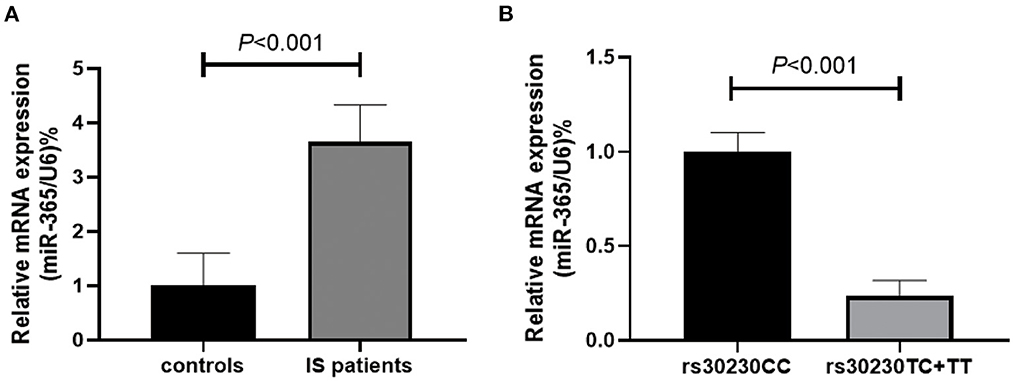
Figure 2. (A) Relative expression of the miR-365 in IS patients (n = 30) and controls (n = 30) in peripheral blood mononuclear cells. (B) The association between rs30230 polymorphism and the expression of miR-365 in IS patients. Patients carrying rs30230 TC or TT genotype (n = 20) had a significantly lower level of miR-365 as compared with the carriers of rs302030 genotype (n = 10).
4. Discussion
This study aimed to investigate the association between the development of IS and three SNPs, namely rs121224, rs30230, and rs178553, in the miR-365 gene. The findings revealed a significant correlation between TC and TT genotypes of the rs30230 polymorphism and a reduced risk of IS. Moreover, our analysis demonstrated that IS patients carrying the TC and TT genotypes of rs30230 had a lower miR-365 expression level compared to their counterparts with the CC genotype. These results suggest that a correlation might exist between the miR-365 rs30230 polymorphism and susceptibility to IS in the Chinese population.
As a member of the microRNAs family, miR-365 plays a vital role in a multitude of biological events, such as chondrocyte development (22), pathogenesis of cancer (23), and atherosclerosis (14). Recently, growing evidence has suggested that miR-365 is implicated in the development of neurological diseases. It was reportedly associated with morphine tolerance and nociceptive behavior (24, 25), and its aberrant expression was observed in the spinal cord of amyotrophic lateral sclerosis rats and in the hippocampus of epileptic rats (26, 27). Of note, the upregulated miR-365 expression led to augmented neurological deficits and brain infarct size by reducing the level of PAX6 expression and the number of newly mature neurons derived from astrocytes in the ischemic striatum (16). The dysregulated expression of miR-365 was also found to be connected to oxidative damage in rat ischemic brain (17). A study using the atherosclerotic model showed that miR-365 enhanced ox-LDL-induced endothelial apoptosis by regulating Bcl-2 expression (28). Furthermore, miR-365 was upregulated in extracellular vesicles isolated from cholesterol-loaded macrophages (29). In another study, multiple target genes related to the regulation of miR-365-2-5p were exhibited to be associated with functions related to cholesterol metabolism (30). These were all promotors to the development of atherosclerosis. Moreover, atherosclerosis is generally believed to be a crucial pathological process underlying cardiovascular diseases. Therefore, it is only natural to theorize that miR-365 might play a crucial part in the development and progression of IS and can be used as a therapeutic target for the treatment of the condition.
Most previous studies investigating the association between genetic polymorphisms and susceptibility to IS have primarily focused on protein-coding genes (31, 32). However, in recent years, research efforts have been increasingly directed at the exploration of the relationship between miRNA-associated polymorphisms and the risk of IS (33). The miRNA gene variants may lead to abnormalities in their expression and may even bear an association with the susceptibility to a certain disease (34, 35). With the advancements in genome-wide research, a growing number of studies have revealed associations between SNPs in miRNA regions and IS. For instance, Han et al. identified an association between the miR-181b gene rs322931 CT/TT genotype and IS susceptibility (36). On the other hand, Li et al. found that the miR-155 expression was elevated in whole-blood samples from IS patients but failed to observe a significant association between miR-155 gene rs767649 polymorphism and miR-155 expression (37). These findings suggest that SNPs may play a crucial role in the etiology of IS. On the strength of the prior results, we were led to hypothesize that SNPs in miR-365 are associated with the risk of IS. In our experimental investigations, we confirmed this hypothesis and found a correlation between miR-365 polymorphism and IS risk. To the best of our knowledge, this is the first study to reveal the relationship between rs30230 and IS. Our results indicated that the rs30230 TC/TT genotype was strongly associated with a reduced risk of IS. Additionally, our findings suggested that the T allele serves as a protective genotype against IS, and the C-T-G haplotype is associated with a decreased risk of IS. However, SNPs rs121224 and rs178553 did not show a significant association with IS susceptibility. Furthermore, we did not find a synergic protective effect of rs121224–rs30230 in combination with rs178553-rs30230 on IS risk possibly due to the limited loci covered by the study, and, presumably, rs121224 may work jointly with other loci to achieve a combined effect, which warrants further study. Our multiple logistic regression analysis identified the rs30230 TC/TT genotype as an independent protective factor for IS. An altered lipid profile is a well-established risk factor for the formation of atherosclerotic plaques. Atherosclerotic plaque formation can lead to blood flow blockage, ischemia, and hypoxia, thereby contributing to severe cardiovascular and cerebrovascular diseases, such as IS and coronary heart disease (38). We then further investigated the relationship between miR-365 SNPs and lipid levels in IS patients. Unfortunately, we failed to observe any significant association. One possible explanation is that the number of IS subjects in our study was relatively small compared to the overall study population, and the observed results might be fortuitous. Another reason might be the potential interaction between these loci and environmental factors during the progression of IS. As shown in Table 8, the genotypes of SNPs vary substantially across regions and races, and both genetic and environmental factors are likely to synergistically influence the susceptibility to disease, which needs further evaluation and exploration.
We then assessed the relative expression of miR-365 in PBMCs in IS patients and controls and found that miR-365 expression was significantly upregulated in IS patients as compared to controls. This result further substantiated our conjecture regarding the potential involvement of miR-365 in IS development. Premised on this finding, we assumed that rs30230 polymorphism might influence miR-365 expression and, consequently, contribute to the progression of IS. To test this assumption, we examined the association between different genotypes of rs30230 in IS patients and miR-365 expression levels. Remarkably, we observed a significantly lower miR-365 level in patients carrying the rs30230 TC or TT genotypes relative to those with the rs30230 CC genotype. This finding lends support to the notion that rs30230 polymorphism in miR-365 is associated with gene expression. These findings collectively suggest that miR-365 and its rs30230 polymorphism may play a crucial role in the pathogenesis of IS.
The current study highlights the significant role of miR-365 polymorphisms in the etiology of IS. However, certain limitations should be acknowledged. First, our analysis was based on a limited set of clinical data, and the sample size for testing was relatively small. Therefore, the association between miR-365 and IS populations should be further confirmed in large-sized samples. Second, it is important to recognize that there might be a potential selection bias since all participants were recruited from a single setting. This limits the extrapolation of our findings to populations with different genetic and environmental backgrounds. Third, IS was known to result from complex interactions between genetic and environmental factors, and genetic polymorphisms may vary with populations. Therefore, caution should be exercised when extrapolating our results to other ethnic or racial populations with varying genetic backgrounds and environmental contexts. To overcome these limitations, future research efforts should incorporate more functional experiments and animal studies for further validation. By doing so, we can gain a deeper insight into the specific role played by these SNPs in the development of IS. Such approaches will help strengthen the validity and reliability of our findings and further enhance our understanding of the link between SNPs and IS.
5. Conclusion
In conclusion, our study provided preliminary evidence that the miR-365 rs30230 polymorphism is associated with susceptibility to IS. Specifically, we observed a protective role of the T allele, TC genotype, TT genotype, and dominant model in the development of IS. These findings underscore the potential of rs30230 as a biomarker for predicting the development and progression of IS.
Data availability statement
The original contributions presented in the study are publicly available. This data can be found here: European Molecular Biology Laboratory's European Bioinformatics Institute (EMBL-EBI), European Variation Archive (EVA), https://www.ebi.ac.uk/eva/, PRJEB65578.
Ethics statement
The studies involving human participants were reviewed and approved by the Review Board of the Affiliated Hospital of Guilin Medical University (2022YJSLL-80). Written informed consent to participate in this study was provided by the patients/participants.
Author contributions
Y-HW: Methodology, Writing—original draft. W-TY: Methodology, Writing—original draft. Y-PL: Formal analysis, Writing—review and editing, Data curation. CL: Data curation, Formal analysis, Writing—review and editing. X-XG: Data curation, Formal analysis, Writing—review and editing. H-YC: Conceptualization, Writing—review and editing. H-BL: Conceptualization, Writing—review and editing. All authors have read and approved the final manuscript.
Funding
The author(s) declare financial support was received for the research, authorship, and/or publication of this article. The study was supported by the National Natural Science Foundation of China (No. 82160313), Guangxi Natural Science Foundation (No. 2020GXNSFDA297027), and Guangxi Medical and Health Key Discipline Construction Project.
Acknowledgments
The authors are indebted to all participants who agreed to take part in the study.
Conflict of interest
The authors declare that the research was conducted in the absence of any commercial or financial relationships that could be construed as a potential conflict of interest.
Publisher's note
All claims expressed in this article are solely those of the authors and do not necessarily represent those of their affiliated organizations, or those of the publisher, the editors and the reviewers. Any product that may be evaluated in this article, or claim that may be made by its manufacturer, is not guaranteed or endorsed by the publisher.
References
1. Paul S, Candelario-Jalil E. Emerging neuroprotective strategies for the treatment of ischemic stroke: an overview of clinical and preclinical studies. Exp Neurol. (2021) 335:113518. doi: 10.1016/j.expneurol.2020.113518
2. Winek K, Lobentanzer S, Nadorp B, Dubnov S, Dames C, Jagdmann S, et al. Transfer RNA fragments replace microrna regulators of the cholinergic poststroke immune blockade. Proc Natl Acad Sci U S A. (2020) 117:32606–16. doi: 10.1073/pnas.2013542117
3. Saini V, Guada L, Yavagal DR. Global epidemiology of stroke and access to acute ischemic stroke interventions. Neurology. (2021) 97:S6–S16. doi: 10.1212/WNL.0000000000012781
4. Mirzaei H. Stroke in women: risk factors and clinical biomarkers. J Cell Biochem. (2017) 118:4191–202. doi: 10.1002/jcb.26130
5. Hankey GJ. Is homocysteine a causal and treatable risk factor for vascular diseases of the brain (cognitive impairment and stroke)? Ann Neurol. (2002) 51:279–81. doi: 10.1002/ana.10134
6. Yadav BK, Yadav R, Chang H, Choi K, Kim JT, Park MS, et al. Genetic polymorphisms Rs699947, Rs1570360, and Rs3025039 on the Vegf gene are correlated with extracranial internal carotid artery stenosis and ischemic stroke. Ann Clin Lab Sci. (2017) 47:144–55.
7. Zhou X, Guan T, Li S, Jiao Z, Lu X, Huang X, et al. The association between Hdac9 gene polymorphisms and stroke risk in the Chinese population: a meta-analysis. Sci Rep. (2017) 7:41538. doi: 10.1038/srep41538
8. Ren Z, Chen X, Tang W, Li J, Yang S, Chen Y, et al. Association of Diaph1 gene polymorphisms with ischemic stroke. Aging (Albany NY). (2020) 12:416–35. doi: 10.18632/aging.102631
9. Shyu HY, Chen MH, Hsieh YH, Shieh JC, Yen LR, Wang HW, et al. Association of Enos and Cav-1 gene polymorphisms with susceptibility risk of large artery atherosclerotic stroke. PLoS ONE. (2017) 12:e0174110. doi: 10.1371/journal.pone.0174110
10. Krol J, Loedige I, Filipowicz W. The widespread regulation of microrna biogenesis, function and decay. Nat Rev Genet. (2010) 11:597–610. doi: 10.1038/nrg2843
11. Lu TX, Rothenberg ME. Microrna. J Allergy Clin Immunol. (2018) 141:1202–7. doi: 10.1016/j.jaci.2017.08.034
12. Zhong C, Yin C, Niu G, Ning L, Pan J. Microrna Mir-497 is closely associated with poor prognosis in patients with cerebral ischemic stroke. Bioengineered. (2021) 12:2851–62. doi: 10.1080/21655979.2021.1940073
13. Ma Q, Zhao H, Tao Z, Wang R, Liu P, Han Z, et al. Microrna-181c exacerbates brain injury in acute ischemic stroke. Aging Dis. (2016) 7:705–14. doi: 10.14336/AD.2016.0320
14. Lin B, Feng DG, Wang F, Wang JX, Xu CG, Zhao H, et al. Mir-365 participates in coronary atherosclerosis through regulating Il-6. Eur Rev Med Pharmacol Sci. (2016) 20:5186–92.
15. Kim MH, Ham O, Lee SY, Choi E, Lee CY, Park JH, et al. Microrna-365 inhibits the proliferation of vascular smooth muscle cells by targeting cyclin D1. J Cell Biochem. (2014) 115:1752–61. doi: 10.1002/jcb.24841
16. Mo JL, Liu Q, Kou ZW, Wu KW, Yang P, Chen XH, et al. Microrna-365 modulates astrocyte conversion into neuron in adult rat brain after stroke by targeting Pax6. Glia. (2018) 66:1346–62. doi: 10.1002/glia.23308
17. Mo JL, Pan ZG, Chen X, Lei Y, Lv LL, Qian C, et al. Microrna-365 knockdown prevents ischemic neuronal injury by activating oxidation resistance 1-mediated antioxidant signals. Neurosci Bull. (2019) 35:815–25. doi: 10.1007/s12264-019-00371-y
18. Arancibia T, Morales-Pison S, Maldonado E, Jara L. Association between single-nucleotide polymorphisms in mirna and breast cancer risk: an updated review. Biol Res. (2021) 54:26. doi: 10.1186/s40659-021-00349-z
19. Yan Z, Zhou Z, Li C, Yang X, Yang L, Dai S, et al. Polymorphisms in miRNA genes play roles in the initiation and development of cervical cancer. J Cancer. (2019) 10:4747–53. doi: 10.7150/jca.33486
20. Wu YF, Xu Q, He CY, Li Y, Liu JW, Deng N, et al. Association of polymorphisms in three pri-miRNAs that target pepsinogen c with the risk and prognosis of gastric cancer. Sci Rep. (2017) 7:39528. doi: 10.1038/srep39528
21. Liu J, Zheng L, Cheng Y, Zhang S, Wu B, Wang D, et al. Trends in outcomes of patients with ischemic stroke treated between 2002 and 2016. Circ Cardiovasc Qual Outcomes. (2019) 12:e005610. doi: 10.1161/CIRCOUTCOMES.119.005610
22. Guan YJ, Yang X, Wei L, Chen Q. MIR-365: a mechanosensitive microrna stimulates chondrocyte differentiation through targeting histone deacetylase 4. FASEB J. (2011) 25:4457–66. doi: 10.1096/fj.11-185132
23. Zhu Y, Wen X, Zhao P. Microrna-365 inhibits cell growth and promotes apoptosis in melanoma by targeting Bcl2 and Cyclin D1 (Ccnd1). Med Sci Monit. (2018) 24:3679–92. doi: 10.12659/MSM.909633
24. Pan Z, Zhang M, Ma T, Xue ZY Li GF, Hao LY, et al. Hydroxymethylation of Microrna-365-3p regulates nociceptive behaviors via Kcnh2. J Neurosci. (2016) 36:2769–81. doi: 10.1523/JNEUROSCI.3474-15.2016
25. Wang J, Xu W, Zhong T, Song Z, Zou Y, Ding Z, et al. Mir-365 targets β-Arrestin 2 to reverse morphine tolerance in rats. Sci Rep. (2016) 6:38285. doi: 10.1038/srep38285
26. Sun Z, Yu JT, Jiang T, Li MM, Tan L, Zhang Q, et al. Genome-wide microrna profiling of rat hippocampus after status epilepticus induced by amygdala stimulation identifies modulators of neuronal apoptosis. PLoS ONE. (2013) 8:e78375. doi: 10.1371/journal.pone.0078375
27. Parisi C, Arisi I, D'Ambrosi N, Storti AE, Brandi R, D'Onofrio M, et al. Dysregulated micrornas in amyotrophic lateral sclerosis microglia modulate genes linked to neuroinflammation. Cell Death Dis. (2013) 4:e959. doi: 10.1038/cddis.2013.491
28. Qin B, Xiao B, Liang D, Xia J, Li Y, Yang H. Micrornas expression in ox-ldl treated huvecs: MIR-365 modulates apoptosis and Bcl-2 expression. Biochem Biophys Res Commun. (2011) 410:127–33. doi: 10.1016/j.bbrc.2011.05.118
29. Nguyen MA, Karunakaran D, Geoffrion M, Cheng HS, Tandoc K, Perisic Matic L, et al. Extracellular vesicles secreted by atherogenic macrophages transfer microrna to inhibit cell migration. Arterioscler Thromb Vasc Biol. (2018) 38:49–63. doi: 10.1161/ATVBAHA.117.309795
30. Dou P, Tan Y, Li K, Hong H, Zhu B, Han QA, et al. Microrna expression profile of cholesterol metabolism analysis mediated by thelenota ananas desulfated holothurin a saponin in Raw2647 macrophage-foam. Cells Food Funct. (2022) 13:11049–60. doi: 10.1039/D2FO01373H
31. Xue H, Wang H, Song X, Li W, Sun K, Zhang W, et al. Phosphodiesterase 4d gene polymorphism is associated with ischaemic and haemorrhagic stroke. Clin Sci (Lond). (2009) 116:335–40. doi: 10.1042/CS20080162
32. Zhao J, Piao X, Wu Y, Xu P, He Z. Association of Saa gene polymorphism with ischemic stroke in Northern Chinese han population. J Neurol Sci. (2017) 380:101–5. doi: 10.1016/j.jns.2017.07.012
33. Liu X, Wang Q, Zhu R. Influence of miRNA gene polymorphism on recurrence and age at onset of ischemic stroke in a chinese han population. Neurotox Res. (2020) 37:781–7. doi: 10.1007/s12640-019-00125-8
34. Slattery ML, Herrick JS, Mullany LE, Wolff E, Hoffman MD, Pellatt DF, et al. Colorectal tumor molecular phenotype and mirna: expression profiles and prognosis. Mod Pathol. (2016) 29:915–27. doi: 10.1038/modpathol.2016.73
35. Hashemi M, Eskandari-Nasab E, Zakeri Z, Atabaki M, Bahari G, Jahantigh M, et al. Association of Pre-miRNA-146a Rs2910164 and Pre-miRNA-499 Rs3746444 polymorphisms and susceptibility to rheumatoid arthritis. Mol Med Rep. (2013) 7:287–91. doi: 10.3892/mmr.2012.1176
36. Han X, Zheng Z, Wang C, Wang L. Association between Meg3/Mir-181b polymorphisms and risk of ischemic stroke. Lipids Health Dis. (2018) 17:292. doi: 10.1186/s12944-018-0941-z
37. Li Y, Peng Y, Yao S, Chen L, Li S, Wang M, et al. Association of Mir-155 and angiotensin receptor type 1 polymorphisms with the risk of ischemic stroke in a chinese population. DNA Cell Biol. (2020) 39:92–104. doi: 10.1089/dna.2019.4948
Keywords: ischemic stroke, polymorphism, miR-365, genotype, risk, miRNA
Citation: Weng Y-H, Yu W-T, Luo Y-P, Liu C, Gu X-X, Chen H-Y and Liu H-B (2023) Association between miR-365 polymorphism and ischemic stroke in a Chinese population. Front. Neurol. 14:1260230. doi: 10.3389/fneur.2023.1260230
Received: 18 July 2023; Accepted: 30 August 2023;
Published: 27 September 2023.
Edited by:
Silvia Giovannini, Catholic University of the Sacred Heart, Rome, ItalyReviewed by:
Ari Nabi, Salahaddin University, IraqHermona Soreq, Hebrew University of Jerusalem, Israel
Copyright © 2023 Weng, Yu, Luo, Liu, Gu, Chen and Liu. This is an open-access article distributed under the terms of the Creative Commons Attribution License (CC BY). The use, distribution or reproduction in other forums is permitted, provided the original author(s) and the copyright owner(s) are credited and that the original publication in this journal is cited, in accordance with accepted academic practice. No use, distribution or reproduction is permitted which does not comply with these terms.
*Correspondence: Huo-Ying Chen, fobufo@163.com; Hong-Bo Liu, hbliu@glmc.edu.cn
†These authors have contributed equally to this work
 Yin-Hua Weng
Yin-Hua Weng Wen-Tao Yu3†
Wen-Tao Yu3† Huo-Ying Chen
Huo-Ying Chen Hong-Bo Liu
Hong-Bo Liu

